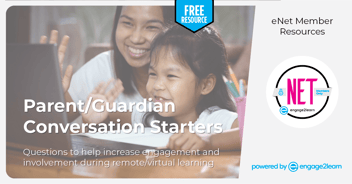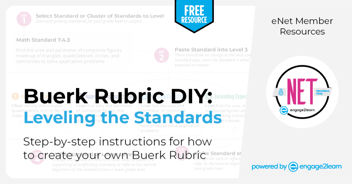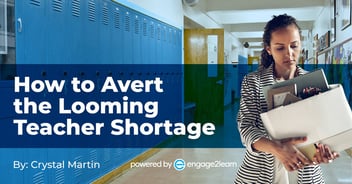3 Steps to Becoming the Teacher Your Students Deserve | engage2learn
Every school year, teachers have the opportunity to push the reset button and start from scratch. In fact, there is no other profession I know of that offers such great “reset” potential. Every year we get a fresh batch of young minds to nurture and grow but let’s be honest, isn’t it just plain easier to show up in August knowing exactly what is going to happen because we have done it a thousand times before? But is that what your students deserve?
This annual “reset” button that educators enjoy presents both an opportunity and a challenge we can choose to embrace or ignore.
In the book “From Good to Great,” Jim Collins stated: “Good is the enemy of Great. And that is one of the key reasons why we have so little that becomes great.” Often times, we settle for “good” because that is easier than continuing to push the boundaries that lead to excellence, to greatness. So, as a matter of equity and integrity, don’t all students deserve to have a teacher who will provide them with the kind of learning environment that will help them thrive and achieve their potential? And, as an educator, shouldn’t I be striving to push the boundaries of that learning environment from good to great?
As great as this sounds, how do we make this happen? Well, it may not be as hard as you think. In fact, here are three easy things you can do this summer to connect to your inner greatness.
1. Foster Your Growth Mindset
Having a growth mindset defines a person who is open-minded, flexible, reflective, and receptive to others’ ideas, recommendations, and input. Even the most proficient teachers know that the key to achieving greatness is their ability to embrace a growth mindset. We know that all students deserve to have teachers who model and strive to get better every day.
To this regard, Carol Dweck states that: “In a growth mindset, people believe that their most basic abilities can be developed through dedication and hard work—brains and talent are just the starting point. This view creates a love of learning and a resilience that is essential for great accomplishment.” Want to know whether you have a fixed or a growth mindset? Then, consider trying one of the many growth mindset assessments available on the web, such as Mindset by Carol Dweck.
Would you agree that improving growth mindset should be a constant goal not only for you, as a teacher, but also for your students?
You can increase your growth mindset by following these actions:
- REFLECTION: Make a list of those things you do well and those you don’t; reflect on the why, what, and how you do some of those things well and others not so well. Chances are when you review the things you do well, you will realize that because you like doing these things or you place a high value on them, you keep practicing, persisting, and finding alternative ways to get better at doing them.
- LOW HANGING FRUIT: Start with one “easy” area you would like to improve on, then develop a realistic, but strategic plan, to improve it. You could replicate this same process to improve other challenging areas.
- ACTION PLAN: Develop your unique action plan, to include specific behaviors and skills you need to exhibit, strengthen or learn in order to master challenging areas.
You can also create opportunities for students to improve their growth mindset by:
- Showing unwavering confidence that all students can learn at high levels, even those who struggle.
- Establishing a learning environment of trust, support, respect, and collaboration.
- Providing ongoing feedback as part of teaching and learning at all levels: teacher to student, student to teacher, student to student.
- Insisting that in your community of learners, including you, making mistakes means we are not there “yet,” but we will continue to persist until we all achieve mastery.
- Embracing diversity by honoring and supporting every student’s learning style, pace, struggles, and needs.
- Establishing an environment focused on providing a safe, nurturing, stimulating, empowering, and engaging learning experience every day.
2. Reconnect with Your Why
Simon Sinek states that people or companies who achieve the most successful outcomes, like Apple, focus on a strategy he calls the “Golden Circle.” This idea proposes that we should always start with our why, then our how, and then our what–in that order. Therefore, reconnecting with our why is of utmost importance and should start our reset process every school year.
Being that starting with our why is so important, during the summertime, you should also determine how your why is purposefully and consistently incorporated into your daily practice. Because we know that our behaviors represent our beliefs, consider how others (students, colleagues, parents, administrators, community) are experiencing your why through your actions, behaviors, and communication on a daily basis? Embracing your why as a springboard to guide your daily practice, actions, decisions, communication, and interactions is essential to becoming and remaining the kind of teacher your students deserve.
Research supports the assertion that teachers who embrace this ongoing process of re-energizing, reflecting, and reconnecting with their why as a matter of practice, produce increased student academic achievement and experience a more gratifying teaching and learning experience for all.
In my own experience, my everyday work in education is anchored to my why. Thanks to the opportunities public education provided me, I was able to “change my starts” and went from poverty to Ph.D. I can do what I do because my teachers and professional mentors believed in me, challenged me cognitively and emotionally, and helped me identify the best opportunities that ultimately allowed me to achieve my potential. And there is more to come…because I am still blessed with having coaches and mentors in my current career in education, so I continue to “pay it forward.”
3. From Isolation to Collaboration: Get a Coach.
Research shows that coaching supports the development and sustainment of individual and collective growth and builds sustainable leadership capacity. Joyce and Showers and Knight assert that investing in the strategic growth of teachers’ knowledge and skills via coaching leads to a higher return on investment and is much more effective than a one time PD or workshop. In his TedTalk, Atul Gawande claims that if you want to get great at something, you should get a coach. He stated that the power of coaching comes from embracing the chance to improve, even if you believe you are on top of your game. After all, Gawande states: “It’s not how good you are now; it’s how good you’re going to be that really matters.”
Indeed, to actively engage in coaching and mentoring opportunities, inside and outside your school is the third step in the process of becoming the teacher your students deserve. Coaching gives you the chance to explore and share scientifically proven practices in a collaborative, trusting, and safe environment. Thus, you are no longer working in isolation and, instead, engage in structured and targeted coaching. Coaching gives you the opportunity to challenge deeply-rooted assumptions you may not even be aware you have, such as I’ve always done it this way, I have good scores with what I’ve been doing, so why change? My students don’t work well in groups, etc. In this process, the main role of the coach is to help the teacher identify the problem of practice, area of growth, or focus.
Coaching is mostly about empowering the teacher to bring his/her own solutions to light. However, if the teacher lacks ideas, resources, or strategies, the coach will be ready to model and/or support based on the teacher’s needs. Coaching could start with simple questions, such as: What could you do about it? What have you tried in the past? Then, through more strategic probing and open-ended questions, the coach facilitates the process of reflection, analysis, and decision-making. The teacher chooses his/her next steps, executes, and then communicates outcomes to the coach. The best coaching, like the best teaching, is always adaptable, flexible, and responsive to the needs of the teacher. The process is ongoing, formative, reflective, and collaborative.
It is through coaching that you can further embrace new, innovative, and research-based paradigms with your students. As a result, you are able to continuously improve and develop a learning environment in which all students can thrive and achieve their potential.
Your Students Deserve Your Best
Whether I am serving students, staff, or other stakeholders as a teacher, administrator or coach, I have always made myself a promise that I will not ever be set in my ways. After more than 30 years in education, I still faithfully follow these three steps. Embracing this process is not only beneficial for me as a professional educator and coach, but it also guides my why. Thus, like all educators should be, I am committed to the relentless pursuit of ensuring that our neighborhood public schools are the first choice for our families and that all public schools are grounded in the moral imperative of achieving equity and excellence for all students.
I am firmly convinced that all students, regardless of zip code, deserve to be welcomed every year by high quality, effective teachers who are caring, well-prepared, and who remain vigilant and open to innovation. Teachers who reset their practice every year with the purpose of providing all students with the kind of education that is responsive to the needs of students and the demands of our modern society.
After all, teaching and learning are about facilitating students’ academic outcomes, personal growth, and improving their readiness for the future. Becoming the teacher your students deserve requires ongoing, intentional effort because as Zig Ziglar says,
“There is no elevator to success, each one of us has to take the stairs.”



